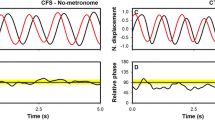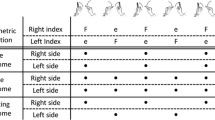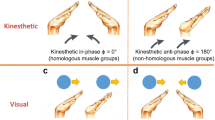Abstract
The relative-salience hypothesis has been proposed as a possible explanation for the stability of bimanual coordination. This explanation proceeds from a psychological viewpoint and is based on the following tenets: (1) cyclic joint motions involving two movements are conceived of as a unified event, (2) if a “single” point in each movement is seen as the most salient, the salient points of the two movements prefer to go together, and (3) in other cases, a unified event will be constrained by movement direction. In this investigation, we examined whether the relative-salience hypothesis could predict the type of constraint (i.e., action coupling vs movement direction) for various bimanual coordination movements. Participants performed six different joint movements in synchrony with metronome beats. Both index finger flexion/extension and forearm pronation/supination had a “single” salient point (JMsingleSP), the others had “two” salient points (JMtwoSP). Then, we applied the relative-salience hypothesis to four bimanual coordinations. The coupling of simultaneous forearm pronation was more stable than alternate pronation. Similarly, the coupling of finger flexion and forearm pronation was more stable than that of finger flexion and forearm supination. For the coordination of radial flexion/ulnar flexion and index finger flexion/extension as well as forearm pronation/supination and radial flexion/ulnar flexion, symmetric movements were more stable than asymmetric movements. The results indicated that the stability of bimanual coordination was predominantly constrained by coupling of salient points when using two JMsingleSP and it was predominantly constrained by movement direction when coordinating JMsingleSP and JMtwoSP. Thus, the relative-salience hypothesis was supported.


Similar content being viewed by others
References
Baldissera F, Cavallari P, Civaschi P (1982) Preferential coupling between voluntary movements of ipsilateral limbs. Neurosci Lett 34:95–100
Beek PJ, Peper CE (2004) Perceptible goals matter, but let’s not overdo it! J Motor Behav 36(4):373–375
Buchanan JJ, Kelso JA (1993) Posturally induced transitions in rhythmic multijoint limb movements. Exp Brain Res 94:131–142
Byblow WD, Carson RG, Goodman D (1994) Expressions of asymmetries and anchoring in bimanual coordination. Hum Mov Sci 13:3–28
Carson RG (1996) Neuromuscular-skeletal constraints upon the dynamics of perception–action coupling. Exp Brain Res 110:99–110
Carson RG, Kelso JAS (2004) Governing coordination: behavioural principles and neural correlates. Exp Brain Res 154:267–274
Carson RG, Riek S (1998) The influence of joint position on the dynamics of perception–action coupling. Exp Brain Res 121:103–114
Carson RG, Goodman D, Kelso JAS, Elliott D (1995) Phase transitions and critical fluctuations in rhythmic coordination of ipsilateral hand and foot. J Motor Behav 27(3):211–224
Carson RG, Chua R, Byblow WD, Poon P, Smethurst CJ (1999) Changes in posture alter the attentional demands of voluntary movement. Proc Biol Sci 266:853–857
Carson RG, Oytam Y, Riek S (2009) Artificial gravity reveals that economy of action determines the stability of sensorimotor coordination. PLoS ONE 4(4):e5248
Dahm SF, Rieger M (2016) Is there symmetry in motor imagery? Exploring different versions of the mental chronometry paradigm. Atten Percept Psychophys 78:1794–1805
Franz EA, Ramachandran VS (1998) Bimanual coupling in amputees with phantom limbs. Nat Neurosci 1:443–444
Harris CM, Wolpert DM (1998) Signal-dependent noise determines motor planning. Nature 394:780–784
Ivry RB, Spencer RM, Zelaznik HN, Diedrichsen J (2002) The cerebellum and event timing. Ann NY Acad Sci 978:302–317
Jirsa VK, Fink P, Foo P, Kelso JAS (2000) Parametric stabilization of biological coordination: a theoretical model. J Biol Phys 26:85–112
Kelso JAS, Buchanan JJ, Wallace SA (1991) Order parameters for the neural organization of single, multijoint limb movement patterns. Exp Brain Res 85:432–444
Kennedy DM, Wang C, Panzer S, Shea CH (2016) Continuous scanning trials: transitioning through the attractor landscape. Neurosci Lett 610:66–72
Kovacs AJ, Buchanan JJ, Shea CH (2009) Bimanual 1:1 with 90° continuous relative phase: difficult or easy! Exp Brain Res 193:129–136
Li Y, Levin O, Carson RG, Swinnen SP (2004) Bimanual coordination: constraints imposed by the relative timing of homologous muscle activation. Exp Brain Res 156:27–38
Maslovat D, Chua R, Lee TD, Franks IM (2006) Anchoring strategies for learning a bimanual coordination pattern. J Mot Behav 38(2):101–117
Mechsner F (2004a) A psychological approach to human voluntary movements. J Motor Behav 36(4):355–370
Mechsner F (2004b) Response to commentaries: actions as perceptual-conceptual “gestalts”. J Motor Behav 36(4):408–417
Mechsner F, Knoblich G (2004) Do muscles matter for coordinated action? J Exp Psychol Hum Percept Perform 30(3):490–503
Mechsner F, Kerzel D, Knoblich G, Prinz W (2001) Perceptual basis of bimanual coordination. Nature 414:69–73
Muraoka T, Ishida Y, Obu T, Crawshaw L, Kanosue K (2013) Ipsilateral wrist-ankle movements in the sagittal plane encoded in extrinsic reference frame. Neurosci Res 75:289–294
Muraoka T, Nakagawa K, Kato K, Qi W, Kanosue K (2016) Interlimb coordination from a psychological perspective. J Phys Fitness Sports Med 5(5):349–359
Nakagawa K, Muraoka T, Kanosue K (2013) Factors that determine directional constraint in ipsilateral hand-foot coordinated movements. Physiol Rep 1(5):e00108
Nakagawa K, Muraoka T, Kanosue K (2015) Potential explanation of limb combination performance differences for two-limb coordination tasks. Physiol Rep 3(2):e12301
Obhi SS (2004) An account of human voluntary movement must be holistic. J Motor Behav 36(4):387–390
Obhi SS, Haggard P (2004) The relative effects of external spatial and motoric factors on the bimanual coordination of discrete movements. Exp Brain Res 154:399–402
Pauwels L, Vancleef K, Swinnen SP, Beets IAM (2015) Challenge to promote change: both young and older adults benefit from contextual interference. Front Aging Neurosci 7:157
Riek S, Carson RG, Byblow WD (1992) Spatial and muscular dependencies in bimanual coordination. J Hum Mov Stud 23:251–265
Roerdink M, Ophoff ED, Peper CE, Beek PJ (2008) Visual and musculoskeletal underpinnings of anchoring in rhythmic visuo-motor tracking. Exp Brain Res 184:143–156
Scholz JP, Kelso JAS (1989) A quantitative approach to understanding the formation and change of coordinated movement patterns. J Motor Behav 21(2):122–144
Spencer RMC, Ivry RB, Cattaert D, Semjen A (2005) Bimanual coordination during rhythmic movements in the absence of somatosensory feedback. J Neurophysiol 94:2901–2910
Swinnen SP, Wenderoth N (2004) Two hands, one brain: cognitive neuroscience of bimanual skill. Trends Cognit Sci 8(1):18–25
Walter CB, Gravenhorst RM (2004) Placing the perceptual-cognitive approach in perspective. J Motor Behav 36(4):400–407
Wang C, Kennedy DM, Boyle JB, Shea CH (2013) A guide to performing difficult bimanual coordination tasks: just follow the yellow brick road. Exp Brain Res 230:31–40
Wishart LR, Lee TD, Cunningham SJ, Murdoch JE (2002) Age-related differences and the role of augmented visual feedback in learning a bimanual coordination pattern. Acta Psychol 110:247–263
Zelaznik HN, Rosenbaum DA (2010) Timing processes are correlated when tasks share a salient event. J Exp Psychol Hum Percept Perform 36(6):1565–1575
Acknowledgements
The author YZ is supported by the scholarship from China Scholarship Council (CSC). This work was partly supported by JSPS KAKENHI Grant Number JP26350701.
Author information
Authors and Affiliations
Corresponding author
Ethics declarations
Conflict of interest
The authors declare that they have no conflict of interest.
Rights and permissions
About this article
Cite this article
Zheng, Y., Muraoka, T., Nakagawa, K. et al. Effect of salient points in movements on the constraints in bimanual coordination. Exp Brain Res 236, 1461–1470 (2018). https://doi.org/10.1007/s00221-018-5236-0
Received:
Accepted:
Published:
Issue Date:
DOI: https://doi.org/10.1007/s00221-018-5236-0




